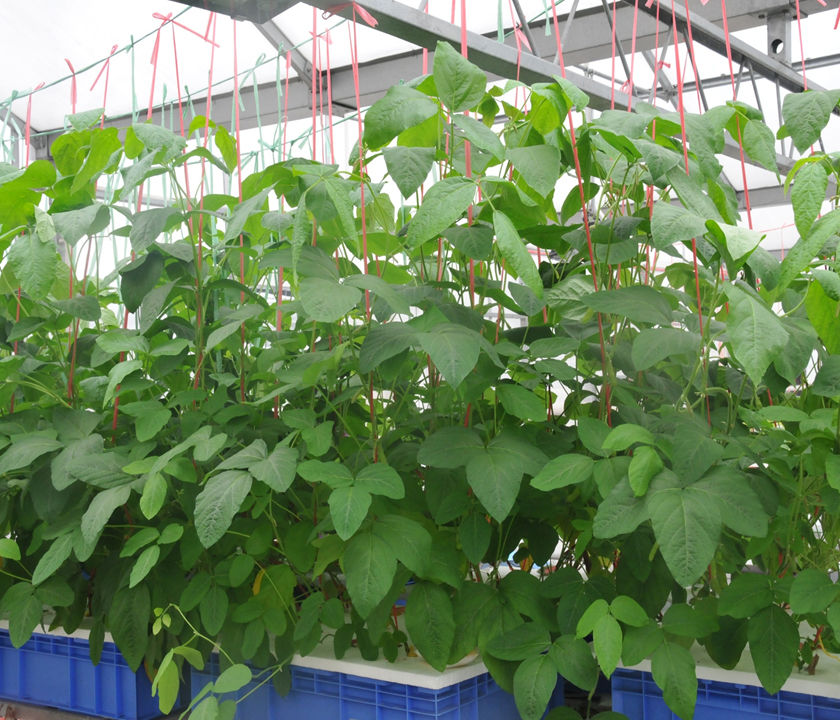

一种高效研究大豆根瘤共生固氮的营养液栽培体系
收稿日期: 2018-01-09
录用日期: 2018-02-12
网络出版日期: 2018-09-11
基金资助
国家自然科学基金(No.31601814)
An Efficient Nutrient Solution System to Study Symbiotic Nitrogen Fixation in Soybean
Received date: 2018-01-09
Accepted date: 2018-02-12
Online published: 2018-09-11
为建立一种既可高效结瘤固氮, 又具有一定产量的大豆(Glycine max)营养液栽培系统, 设计并进行了2个试验。首先在不同供氮条件下, 研究了接种根瘤菌对大豆的结瘤状况、固氮能力、生物量及产量的影响。结果表明, 供氮过高或过低, 均影响大豆生长、产量形成及根瘤固氮; 并且植物生长所需的最适供氮水平远高于生物固氮所需的最适供氮水平。此外, 大豆生物固氮活性最高的时期在生殖期第一期(R1期)之前。由此推断, 大豆R1期前, 供应较低的氮, 有利于根瘤形成及固氮; 而从R1期起, 应提高供氮水平, 以促进植物生长及产量的形成。在此基础上开展第2个试验, 对供氮条件进行了优化处理(即R1期前低氮供应、R1期开始中氮供应)。结果表明, 与持续供应高氮相比, 优化供氮处理不仅可获得较多固氮酶活性较高的大根瘤, 还能保持较好的生长、获得更高的百粒重及维持80%左右的产量。研究结果不仅可为高效研究大豆根瘤共生固氮提供营养液配方, 还可为大豆高产高效栽培提供试验依据。

艾文琴, 姜瀚原, 李欣欣, 廖红 . 一种高效研究大豆根瘤共生固氮的营养液栽培体系[J]. 植物学报, 2018 , 53(4) : 519 -527 . DOI: 10.11983/CBB18007
To establish a nutrient solution system for soybean cultivation with effective nodulation and relatively high yield, we first evaluated the effect of nitrogen (N) content and rhizobia inoculation on soybean growth, yield and biological nitrogen fixation (BNF). Too high or too low N supply affected soybean growth, yield and N2 fixation capacity. Also, the required optimal N level was much higher for plant growth than that of BNF. Furthermore, the highest nitrogenase activity in soybean occurred before the first stage of reproduction (R1 stage). Thus, the enzyme activity could facilitate nodule formation and N2 fixation with a lower N supply before the R1 stage and a higher N supply afterward to promote plant growth and yield in soybean. A second experiment was conducted to optimize N supply (i.e., low N supply before R1 and medium N supply at the beginning of R1). As compared with continuously supplied high N, the optimal scheme promoted BNF with more and larger nodules with higher nitrogenase activity and also maintained a good growth performance with higher 100 grain weight and about sustained 80% of soybean yield. These results provide a reference for nutrient receipt for soybean BNF study as well as soybean production for high yield and nutrient efficiency.

Key words: soybean; nodule; biological nitrogen fixation; nutrient solution; yield
| 1 | 陈文新, 陈文峰 (2004). 发挥生物固氮作用减少化学氮肥用量. 中国农业科技导报 6(6), 3-6. |
| 2 | 程凤娴, 曹桂芹, 王秀荣, 赵静, 严小龙, 廖红 (2008). 华南酸性低磷土壤中大豆根瘤菌高效株系的发现及应用. 科学通报 53, 2903-2910. |
| 3 | 邸伟, 金喜军, 马春梅, 龚振平, 董守坤, 张磊 (2010). 施氮水平对大豆氮素积累与产量影响的研究. 核农学报 24, 612-617. |
| 4 | 胡浩南, 敖俊华, 黄晓财, 李欣欣, 廖红 (2017). 甘蔗不同组织联合固氮能力评价. 植物生理学报 53, 437-444. |
| 5 | 李欣欣, 许锐能, 廖红 (2016). 大豆共生固氮在农业减肥增效中的贡献及应用潜力. 大豆科学 35, 531-535. |
| 6 | 李艳, 盖钧镒 (2017). 大豆向热带地区发展的遗传基础. 植物学报 52, 389-393. |
| 7 | 李宗盛, 李展辉, 邓建军 (1986). 不同时期施氮对大豆产量影响的研究. 土壤肥料 (6), 46-47. |
| 8 | 罗进, 曹智 (2017). 2016年国内外大豆市场回顾及2017年展望. 中国畜牧杂志 53(4), 160-165, 178. |
| 9 | 彭玉新 (2009). 施肥对大豆产量及品质的影响研究. 现代农业科技(18), 19, 21. |
| 10 | 王庆胜 (2010). 根瘤菌对大豆产量及品质的影响. 黑龙江农业科学(9), 138, 147. |
| 11 | Alam F, Bhuiyan MAH, Alam SS, Waghmode TR, Kim PJ, Lee YB (2015). Effect of Rhizobium sp. BARIRGm901 ino- culation on nodulation, nitrogen fixation and yield of soybean(Glycine max) genotypes in gray terrace soil. Biosci Biotechnol Biochem 79, 1660-1668. |
| 12 | Alves BJR, Boddey RM, Urquiaga S (2003). The success of BNF in soybean in Brazil.Plant Soil 252, 1-9. |
| 13 | Brewin NJ (1991). Development of the legume root nodule.Annu Rev Cell Biol 7, 191-226. |
| 14 | Daimon H, Hori K, Shimizu A, Nakagawa M (1999). Nitrate-induced inhibition of root nodule formation and nitrogenase activity in the peanut (Arachis hypogaea L.). Plant Prod Sci 2, 81-86. |
| 15 | Fujikake H, Yamazaki A, Ohtake N, Sueyoshi K, Matsuhashi S, Ito T, Mizuniwa C, Kume T, Hashimoto S, Ishioka NS, Watanabe S, Osa A, Sekine T, Uchida H, Tsuji A, Ohyama T (2003). Quick and reversible inhibition of soybean root nodule growth by nitrate involves a decrease in sucrose supply to nodules.J Exp Bot 54, 1379-1388. |
| 16 | Gan YB, Stulen I, van Keulen H, Kuiper PJC (2004). Low concentrations of nitrate and ammonium stimulate nodulation and N2 fixation while inhibiting specific nodulation (nodule DW·g-1 root dry weight) and specific N2 fixation (N2 fixed·g-1 root dry weight) in soybean.Plant Soil 258, 281-292. |
| 17 | Hungria M, Campo RJ, Mendes IC (2005). Reinoculation increasing soybean grain yield in Brazil. In: Proceedings of the 14th International Nitrogen Fixation Congress. Dordrecht: Springer. pp. 315-315. |
| 18 | Hungria M, Franchini JC, Campo RJ, Crispino CC, Mor- aes JZ, Sibaldelli RNR, Mendes IC, Arihara J (2006). Nitrogen nutrition of soybean in Brazil: contributions of biological N2 fixation and N fertilizer to grain yield.Can J Plant Sci 86, 927-939. |
| 19 | Li XX, Zhao J, Tan ZY, Zeng RS, Liao H (2015). GmEXPB2, a cell wall β-expansin, affects soybean nodulation through modifying root architecture and promoting nodule formation and development.Plant Physiol 169, 2640-2653. |
| 20 | Qin L, Jiang H, Tian J, Zhao J, Liao H (2011). Rhizobia enhance acquisition of phosphorus from different sources by soybean plants.Plant Soil 349, 25-36. |
| 21 | Qin L, Zhao J, Tian J, Chen LY, Sun ZA, Guo YX, Lu X, Gu M, Xu GH, Liao H (2012). The high-affinity phosphate transporter GmPT5 regulates phosphate transport to nodu- les and nodulation in soybean.Plant Physiol 159, 1634-1643. |
| 22 | Saito A, Tanabata S, Tanabata T, Tajima S, Ueno M, Ishikawa S, Ohtake N, Sueyoshi K, Ohyama T (2014). Effect of nitrate on nodule and root growth of soybean (Glycine max (L.) Merr.). Int J Mol Sci 15, 4464-4480. |
| 23 | Tang F, Yang SM, Liu JG, Zhu HY (2016). Rj4, a gene controlling nodulation specificity in soybeans, encodes a thau- matin-like protein but not the one previously reported. Plant Physiol 170, 26-32. |
| 24 | Wang D, Yang SM, Tang F, Zhu HY (2012). Symbiosis specificity in the legume-rhizobial mutualism.Cell Microbiol 14, 334-342. |
/
| 〈 |
|
〉 |